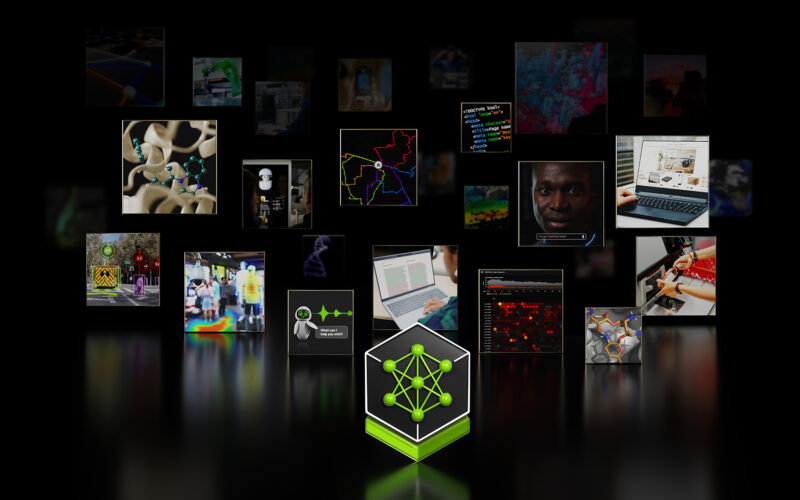The race to build good artificial intelligence apps is a long one and getting off the starting block from zero can be difficult without some kind of an advantage.
To provide customers that advantage, Nvidia Corp. announced NIM Agent Blueprints today that it says include everything an enterprise developer needs to build and deploy generative AI applications from start to finish.
Nvidia NIM microservices provide developers efficient access to AI models for generative AI workflows such as digital human customer service chatbots, retrieval augmented generation and drug discovery. The creation of production-ready apps using AI models is a complicated process requiring multiple tools and expert workers. Making that process more accessible by providing directed templates for well-known business use cases can speed up the creation of these apps, the company said.
“The enterprise AI wave is here,” said Jensen Huang, founder and chief executive of Nvidia. “With the Nvidia AI Enterprise toolkit – including NeMo, NIM microservices and the latest NIM Agent Blueprints – our expansive partner ecosystem is poised to help enterprises customize open-source models, build bespoke AI applications and deploy them seamlessly across any cloud, on-premises or at the edge.”
Gartner reported that AI is well on its way to adoption across the enterprise with 80% of conversational offerings planning to embed generative AI by 2025, a percentage up from 20% in 2024.
NIM Agent Blueprints will launch with three AI workflows for developers to get running with immediately based on some of the the most common industry business use cases. The first is a digital human NIM Agent Blueprint for customer service applications that will help enterprise users build chatbots that can interactively work with customers and customer service operators in text and voice. It can also tailor experiences with 3D animated avatar interfaces.
A new multimodal PDF extraction workflow agent for the enterprise would allow developers to quickly build an app capable of reading through massive volumes of documents to feed and unlock insights. With this workflow, Nvidia said, AI agents and customer service chatbots will quickly become experts on the company topics contained within PDF documents by using retrieval-augmented generation, a way to raise accuracy of generative AI apps and reduce errors by including real-time data.
Finally, Nvidia included a generative virtual screening NIM Agent Blueprint for drug discovery aimed at helping pharmaceutical companies accelerate the time to optimize potential drug-like molecules when working with human experts. This would help significantly reduce the costs of generating life-saving drugs by increasing the probability of success by screening out molecules that would not work in lab conditions.
Although current machine-learning techniques work well in screening drugs, they use physics-based pattern matching alongside human intuition that finally goes to lab to finalize the protein prediction. Researchers and application developers can use the expert knowledge of real-world research and activity to refine AI models to get better predictions and thus save time. The blueprint incorporates well-known protein predictors such as AlphaFold2, MolMM and DiffDock.
Nvidia said additional blueprints will be released monthly for other industries to incorporate other business use applications, including customer service, content generation, software engineering and product research and development.
Nvidia is partnering with several large enterprises businesses to incorporate and distribute the new NIM Agent Blueprints. Professional services firm Accenture, networking technology firm Cisco Systems Inc., Dell Technologies Inc., consulting firm Deloitte Ltd., Hewlett Packard Enterprise Co., Lenovo, IT consulting firm SoftServe Inc. and global systems integrator World Wide Technology Inc. are among the first partners to join.
“Across industries, generative AI is acting as a catalyst for companies looking to reinvent with tech, data and AI,” said Julie Sweet, chair and chief executive of Accenture. “By integrating Nvidia’s catalog of workflows into Accenture’s AI Refinery, we can help our clients develop custom AI systems at speed and reimagine how they do business and serve their customers to drive stronger business outcomes and create new value.”
Image: Nvidia
Your vote of support is important to us and it helps us keep the content FREE.
One click below supports our mission to provide free, deep, and relevant content.
Join our community on YouTube
Join the community that includes more than 15,000 #CubeAlumni experts, including Amazon.com CEO Andy Jassy, Dell Technologies founder and CEO Michael Dell, Intel CEO Pat Gelsinger, and many more luminaries and experts.
THANK YOU
Source link
lol

